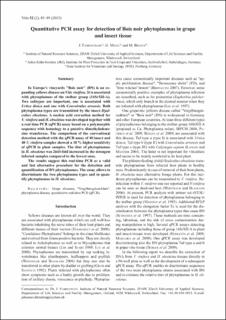Bitte benutzen Sie diese Kennung, um auf die Ressource zu verweisen:
https://doi.org/10.21256/zhaw-2679| Publikationstyp: | Beitrag in wissenschaftlicher Zeitschrift |
| Art der Begutachtung: | Peer review (Publikation) |
| Titel: | Quantitative PCR assay for detection of bois noir phytoplasmas in grape and insect tissue |
| Autor/-in: | Fahrentrapp, Johannes Michl, Gertraud Breuer, Michael |
| DOI: | 10.21256/zhaw-2679 |
| Erschienen in: | Vitis - Journal of Grapevine Research |
| Band(Heft): | 52 |
| Heft: | 2 |
| Seite(n): | 85 |
| Seiten bis: | 89 |
| Erscheinungsdatum: | 2013 |
| Verlag / Hrsg. Institution: | Julius Kühn Institute for Grapevine Breeding |
| ISSN: | 0042-7500 2367-4156 |
| Sprache: | Englisch |
| Schlagwörter: | Phytoplasma disease; Quantitative real-time PCR (qPCR); "Vergilbungskrankheit"; Grape disease |
| Fachgebiet (DDC): | 572: Biochemie 634: Obstanlagen, Früchte und Forstwirtschaft |
| Zusammenfassung: | In Europe's vineyards "Bois noir" (BN) is an expanding yellows disease on Vitis vinifera. It is associated with phytoplasmas of the stolbur group (16SrXII-A). Two subtypes are important, one is associated with Urtica dioica and one with Convolvulus arvensis. Both phytoplasma types are transmitted by the insect Hyalesthes obsoletus. A nucleic acid extraction method for V. vinifera and H. obsoletus was developed together with a real time PCR (qPCR) assay based on a polymorphic sequence with homology to a putative dimethyladenosine transferase. The comparison of the conventional detection method with the qPCR assay of 40 insect and 40 V. vinifera samples showed a 10% higher sensitivity of qPCR in plant samples. The titer of phytoplasmas in H. obsoletus was 2643-fold increased in the strongest infected samples compared to the lowest ones. The results suggest this real-time PCR as a valid and fast alternative procedure for the detection and quantification of BN phytoplasmas. The assay allows to discriminate the two phytoplasma types and to quantify phytoplasmas in H. obsoletus. |
| URI: | https://digitalcollection.zhaw.ch/handle/11475/4096 |
| Volltext Version: | Publizierte Version |
| Lizenz (gemäss Verlagsvertrag): | CC BY 4.0: Namensnennung 4.0 International |
| Departement: | Life Sciences und Facility Management |
| Organisationseinheit: | Institut für Umwelt und Natürliche Ressourcen (IUNR) |
| Publiziert im Rahmen des ZHAW-Projekts: | Detection of Bois noir phytoplasma in the vectoring ciciid Hyalethes obsoletus. |
| Enthalten in den Sammlungen: | Publikationen Life Sciences und Facility Management |
Dateien zu dieser Ressource:
| Datei | Beschreibung | Größe | Format | |
|---|---|---|---|---|
| 2013_Fahrentrapp_Quantitative PCR assay_VITIS.pdf | 525.04 kB | Adobe PDF |  Öffnen/Anzeigen |
Zur Langanzeige
Fahrentrapp, J., Michl, G., & Breuer, M. (2013). Quantitative PCR assay for detection of bois noir phytoplasmas in grape and insect tissue. Vitis - Journal of Grapevine Research, 52(2), 85–89. https://doi.org/10.21256/zhaw-2679
Fahrentrapp, J., Michl, G. and Breuer, M. (2013) ‘Quantitative PCR assay for detection of bois noir phytoplasmas in grape and insect tissue’, Vitis - Journal of Grapevine Research, 52(2), pp. 85–89. Available at: https://doi.org/10.21256/zhaw-2679.
J. Fahrentrapp, G. Michl, and M. Breuer, “Quantitative PCR assay for detection of bois noir phytoplasmas in grape and insect tissue,” Vitis - Journal of Grapevine Research, vol. 52, no. 2, pp. 85–89, 2013, doi: 10.21256/zhaw-2679.
FAHRENTRAPP, Johannes, Gertraud MICHL und Michael BREUER, 2013. Quantitative PCR assay for detection of bois noir phytoplasmas in grape and insect tissue. Vitis - Journal of Grapevine Research. 2013. Bd. 52, Nr. 2, S. 85–89. DOI 10.21256/zhaw-2679
Fahrentrapp, Johannes, Gertraud Michl, and Michael Breuer. 2013. “Quantitative PCR Assay for Detection of Bois Noir Phytoplasmas in Grape and Insect Tissue.” Vitis - Journal of Grapevine Research 52 (2): 85–89. https://doi.org/10.21256/zhaw-2679.
Fahrentrapp, Johannes, et al. “Quantitative PCR Assay for Detection of Bois Noir Phytoplasmas in Grape and Insect Tissue.” Vitis - Journal of Grapevine Research, vol. 52, no. 2, 2013, pp. 85–89, https://doi.org/10.21256/zhaw-2679.
Alle Ressourcen in diesem Repository sind urheberrechtlich geschützt, soweit nicht anderweitig angezeigt.